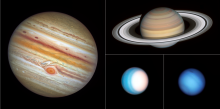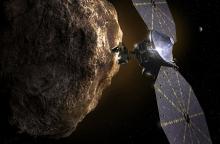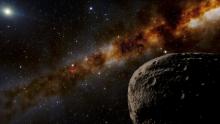Listen to today's episode of StarDate on the web the same day it airs in high-quality streaming audio without any extra ads or announcements. Choose a $8 one-month pass, or listen every day for a year for just $30.
You are here
Venus and Jupiter
Two planets will flip positions in the dawn sky over the next few days. They’re quite low in the sky, so you need a clear horizon to spot them. But they’re the brightest objects in the night sky other than the Moon, so they do stand out.
The brighter member of the duo is Venus, the brilliant “morning star.” Tomorrow, it stands above its companion, Jupiter. But they’ll be side by side on Monday, with Jupiter pulling away from Venus on Tuesday.
To the eye alone, the two planets look a lot alike. And they do have a few things in common. The main one is that both worlds are blanketed by clouds, which reflect a lot of the sunlight that strikes them — one reason that both of them look so bright.
But there are more differences than similarities.
Venus, for example, is roughly the size of Earth — a ball of solid rock topped by a thin layer of atmosphere. Jupiter, on the other hand, is the largest planet in the solar system — big enough to hold more than 1300 Earths. Jupiter probably has a rocky core, but the core is surrounded by layers of hydrogen and helium — in both metallic and liquid forms. Those layers are topped by an atmosphere that’s thousands of miles thick — a world that’s quite different from its smaller sibling.
So keep an eye on these worlds as dawn twilight colors the sky the next few mornings. Venus will disappear from view in a few days, but Jupiter will stand higher each day as it begins a long climb across the night sky.





